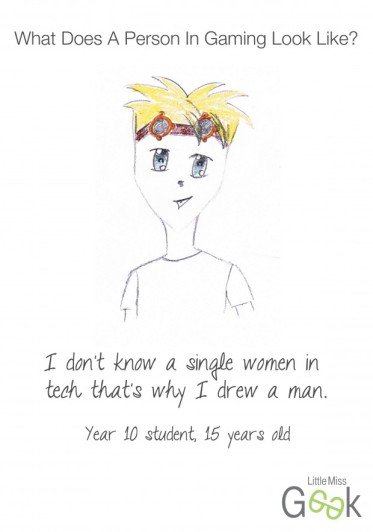Gender inequality is a very big problem worldwide. This is especially true in technology. The recent Twitter IPO fiasco is an excellent example that illustrates the problem and the kind of reactions this topic evokes.
There has been plenty of material written about gender inequality, mainly in the US. Europe, as usual, lags on dealing with the elephant in the room.
While there's plenty of research highlighting the issue at hand, and how pervasive it is, there isn't that much research on the reasons why it became a problem in the first place. The book Unlocking the clubhouse (MIT Press 2003) analyses the roots of the gender inequality problem in STEM (Science, Technology, Engineering and Mathematics) degrees:
“Very early in life, computing is claimed as male territory. At each step in early childhood through collage, computing is both actively claimed as “guy stuff” by boys and men and passively ceded by girls and women. Careful observation shows that disinterest and dissatisfaction are neither genetic nor accidental nor inherent to the field but are the bitter fruit of many external influences.”
The book is based on 230 interviews conducted between 1995 and 1999 at Carnegie Mellon University, home of one of the top computer sciences departments in the world. In it, researchers pinpoint culture and male pressure as the major reasons why women either don't enrol in a STEM degree program, or become drop-outs.
A recent Yale study (2012), shows how there is a slight, but consistent, bias towards men in the scientific world, a world where, supposedly, objectivity is king. The research manifested that women were as biased towards men being superior in science as men were about themselves.
Such inequality isn't just something that affects STEM degrees; the ramifications can be witnessed far beyond tertiary education. The World Economic Forum touches upon other aspects of the problem on their Global Gender Gap Report of 2013. The index is a compounded score of four sub-indexes: economic participation and opportunity, educational attainment, health and survival and political empowerment, totaling fourteen different indicators.
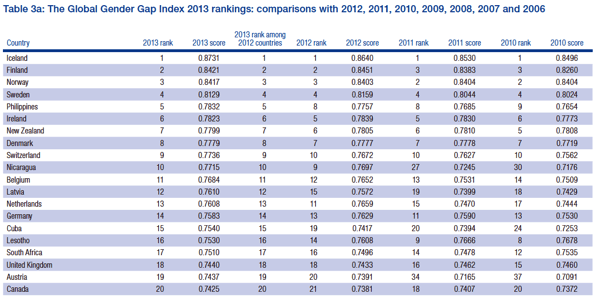
Status in Europe
Is this a widespread issue, or is Europe different? It seems that out of the top 20 countries that fare better in gender equality, thirteen of them are European. If you compound the index values of all European countries, the picture isn't that pretty. When taking Europe as a region, the old continent lags behind North America, and comes in only slightly ahead of Latin America and the Caribbean.
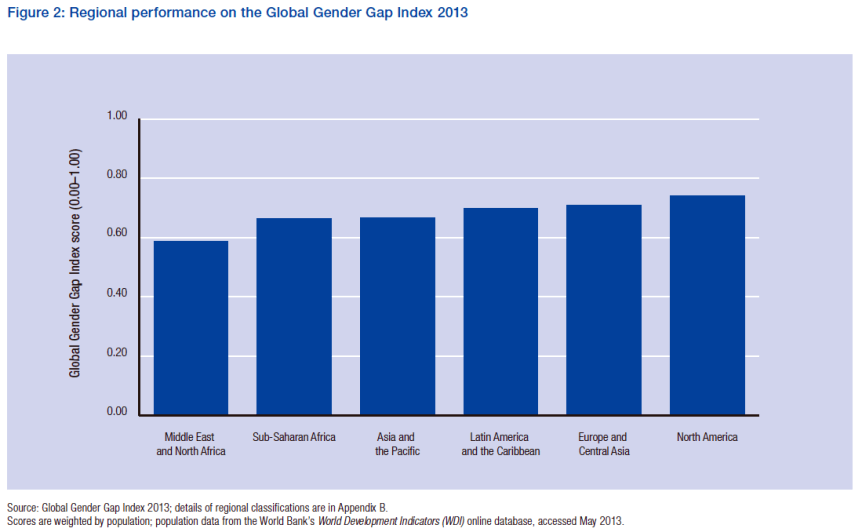
Europe has been trying to close the gap by developing programs to provide support for women in technology through several organizations. The ECWT (European Center for Women and Technology), a partnership of more than 130 organizations that support women in technology across Europe, is one of the most prominent.
Another one is WiTEC, a non-profit European association with 25 years of history of promoting studies and activities related to empowering women in the field of technology, science and engineering.
The problem, however, is good old fragmentation: how does one combat gender inequality across the entire European continent, which spans more than 10 million square kilometres?
A quick glance through EWCT's extensive document base reveals that most of the contributing countries are either from the Nordics, UK or North America, making it clear that not all of Europe makes it a priority. Actually, plotting the Gap Index values across all Europe, paints an insightful picture:
The index rapidly decreases when you start heading to the Southeastern part of Europe, and engulf most of the countries that aren't part of the European Union. This is one of the major challenges for Europe: to ensure that new countries start consistently prioritising gender equality, across the board.
Gender inequality can be defined quite broadly, we ought to note. One of the key recurring themes when talking about women in technology is how much education impacts this imbalance. Luckily, the Global Gender Index covers, among several sub-indexes, education and identifies it as one of the critical ones.
We took a deep dive into the different indicators for education, especially women enrolled in STEM degrees, and how they evolve region by region. The conclusions are quite striking.
Note: The abrupt jump of Eastern Europe is due to former Yugoslavia countries finally capturing such date for UNESCO.
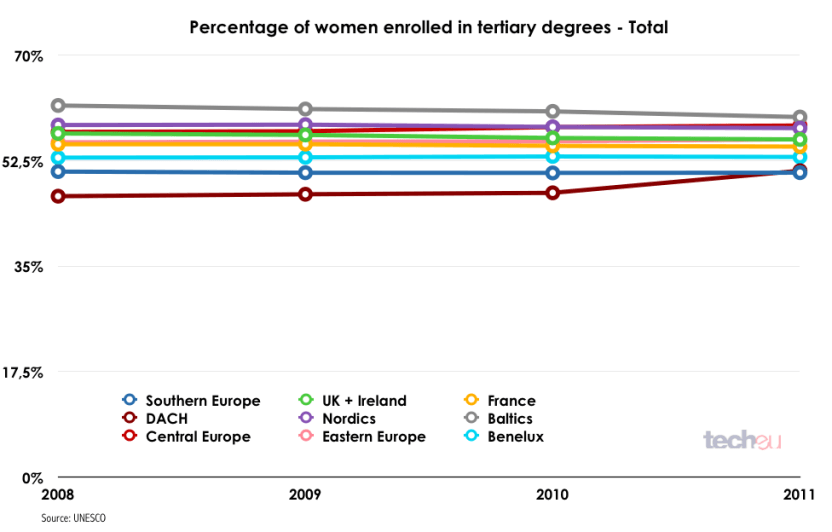
Note: The abrupt jump of the DACH region is due to incomplete UNESCO data from Germany (2008-2010).
The first thing that stands out is that the region with the most number of women enrolled in STEM degrees is Eastern Europe, with a mere 8,13%. Let me repeat that, out of all the women in tertiary education (56% in Eastern Europe in 2011), only 8,13% of them enrol in STEM degree programs, and that's the highest score. Don't even get us started about the Benelux and Baltic regions.
It also seems that Southern Europe took a dip at the same time the financial crisis hit the region, which begs the question how much damage has the crisis brought Europe in the form of wider gender inequality and disgustingly high unemployment among its youth.
Despite those rather gloomy numbers, there has been growth. According to the last She Figures report from 2012, there has been a slow but steady compounded growth of women entering STEM careers and landing employment as scientists or engineers.
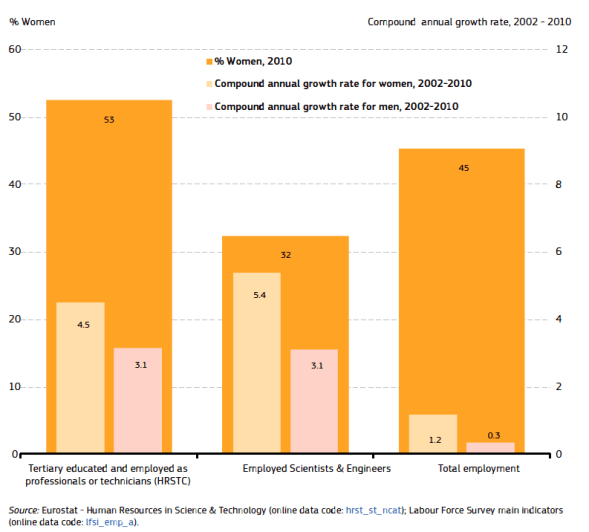
The question remains: what exactly is Europe doing to foster and empower women in STEM fields?
Women in technology groups
One of the main themes I've encountered while doing research for this article was the clear need for more female role models in technology.
As Heather Leisman, European managing director at Hotel Tonight explains:
"I have been fortunate throughout my career to have had strong professional role models, but I consider myself even luckier because many of these role models were women. I knew I wanted to be in their shoes someday, and the female leaders went the extra mile to help me prepare me.
While I value the mentorship and guidance that I received from all my role models, I believe having these women in my life helped me realize my dream of becoming a leader." On one hand, there are a couple of pan-European awards that make an earnest attempt at recognising extraordinary women in the digital space, one of which is the ADAS (European Digital Women Awards).
On the other hand, a different approach is taken by identifying and celebrating great role models, like the case of the Top 100 Women in Tech picked by Girls in Tech UK in 2012 or the Inspiring 50 list from 2013.
Broadly speaking, there seem to be three different types of groups advancing women in technology.
The first one is made up of organisations that are trying to encourage young girls into taking a STEM degree as their future career path. This is, by far, the hardest thing to achieve, but the results they're obtaining so far are very encouraging.
Within this segment, initiatives like Little Miss Geek - founded by Lady Geek CEO Belinda Parmar - are worth highlighting:
“Little Miss Geek is inspiring the next generation of young girls to change the world through technology. We will do for the tech industry what Jamie Oliver did for school dinners; to cause nationwide change from the ground up."
Another organization in this space is Digigirls, from Estonia.
They recently launched their first event for girls between the 9th and the 12th grade. The event was overbooked in less than 12 hours, which is extraordinary when you take into account that they only reached out to five of the twenty schools in capital Tallinn.
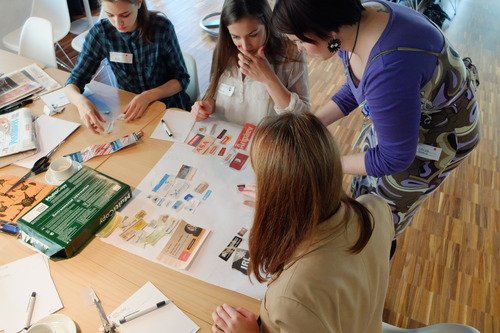
From education to employment
This first segment is not common; it takes a lot of effort and it’s hard to grow the movement due to its local nature. That said, we're glad that there are people brave enough to try to tackle it. The second group is focused on encouraging more women to take jobs in technology.
This one is also a hard nut to crack. Most of the groups showcase prominent females in tech who try to inspire other women to change career paths. Kadri Uljas, one of the organizers of Digigirls, tell us:
“The reason is that they were either afraid of technology when they decided what to study, on the basis of not being good enough, or they don't think they can change their professional focus when they are already working in some field.
We want to show women and girls that they are wrong. We want to guide them as we would have loved someone had guided us when we were making the decisions.” Within this segment, we also find organisations such as Berlin Geekettes in Germany (which just announced their global expansion), Geek Girls in the UK, TechSisters in Estonia, Girls in Tech (France, UK, Romania, Italy, Portugal and rapidly expanding across Europe - Luxembourg, Switzerland, Belgium and Scandinavia), Ellas 2.0 in Spain, Girlz in tech in France and many others. As Catalina Rusu from Girls in Tech Romania puts it:
“Girls in Tech Romania organizes workshops or meetups where European women from the tech industry or any other industries like investment, marketing, management or product development share their experiences, answer questions and try to debunk myths that exist around what women do, or how are they treated in each industry.”
It’s important to notice that, despite the names, these organizations are very open to just about anyone, at least in Europe. Girls In Tech (and tech.eu) co-founder Roxanne Varza comments:
“Girls in Tech is oriented towards innovation/entrepreneurship. Our events are NOT closed to men (in the US it's a different model) and we even have guys on the team in France. Our goal is to help incredible women get more visibility. We don't invite people just because they are women to speak at our events but rather because they are women doing incredible things.
No woman wants to be recognized just because of her gender. Our events never treat "female" topics - we're not there to talk about having kids and such, but rather to discuss business, like any other conference.” Within this bunch, some are quite broad and others are more focused on helping women enter the entrepreneurial world, be it as CEOs, coders, project managers or growth hackers.
Such is the case for organizations like Agile Girls in Madrid, JDuchess in Amsterdam or Rails Girls, which started out in Finland and now operates in several countries like Estonia, Germany, Poland, and even China and Singapore.
Some of these groups are quite focused, and play a critical role when it comes to the future of female entrepreneurs and the ecosystem’s need of a healthier mix. That’s the case of Angel Academe in the UK, an organization focused on building a female-friendly angel group, similar to what Golden Seeds and Pipeline fellowship are doing in the US.
Its founder, Sarah Turner, explains:
“Less than 5% of angel investors in the UK are women. I believe this makes it much harder for women to raise funding and creates an exciting opportunity to attract more early stage capital into the market from very savvy professional women, and target female founders - both of which are underserved in the angel market.”
Supporting support
Finally, the third group of organisations tends to be closer to a women-only support group, spanning across multiple industries. They’re seen more as a place where women can share their experiences, ranging from how to balance work with private life to getting closer to technology without feeling that they don’t belong there. Some examples on such organisations are Womenalia in Spain or SmartWomen-SmartConversations (SWSC) in the UK. Heather Leisman has experienced this firsthand:
"The network of leaders that I have built in London is irreplaceable to me. These are the people that I consult when I have questions, want to bounce around ideas and rely on for advice. But like it or not, women leaders face different challenges and as such, I believe its essential for women to have a forum when they can share and learn from each other's unique experiences."
This final group is mostly comprised of the same organisations we've highlighted before. In most cases, they act as dual organisations, managing training, inspirational talks and support groups - all in one. Actually, many of the organisations listed above go back and forth between each group, some of them also working on kids initiatives as spin-offs of their chapters.
Carmen Bermejo, CEO of Tetuan Valley, tells us:
“The atmosphere in Agile Girls, , is more open and less competitive. Some women tend to stay in the background during most events, or don't even attend tech events at all. During our gatherings, they feel more comfortable to participate in the conversation, and even to teach others what they know.”
Where are the corporates?
All of these organisations are mostly private initiatives, and are supported largely by sponsors, including Microsoft, Google or Facebook, to name some of the most prominent.
This bring us to the final piece of the ecosystem, multinational corporations. While some of them run internal programs to help women advance in technology-driven environments, it’s surprising to see just how few there are.
Some good examples are Dell's Women Powering Business (US), Mozilla and their Women & Mozilla group (US), Microsoft and their diversity programs like DigiGirlz (US) or Women in Technology. The irony here is that non of these companies are European, but still, they’re using their local European chapters to help. Also, while many of them are quite successful, there seems to be subject to quite some internal criticism. According to an anonymous source from Microsoft:
“They are very active in the UK, for example, but the initiative is still very internally-oriented. It's great to promote women to get recognition within a big company but it's definitely worthwhile to invest more into helping these women get recognized in the community. If you're doing something great and only your colleagues know, what's the point?”
It is true though that, while some of the corporations don't have specific programs for women in technology, they informally support such efforts via sponsorship of the private groups we mentioned before. This is the case of Wayra UK program, Google or Facebook. Despite this, it's surprising how few multinational technology corporations are involved in promoting women in technology. What are telecommunication companies like Telefonica, BT or Deutsche Telekom doing beyond meeting a 'healthy' quota? And what about the larger startups like Skype, Zalando or Spotify? Don’t they have a responsibility as technology leaders in Europe?
Accelerating women in tech
While there is much talk about startups failing to include women in their ranks, there is a niche in the startup world that deserves special attention: startup accelerators.
I've been a mentor in multiple startup accelerators across Europe, and nearly every single time I've been dealing with women. Springboard was run among others by Jess Williamson (currently Techstars London). The now-defunct HackFWD was run, among others, by Jana von Dach and Stephanie Gerth. Startup Wise Guys had first Elise Saas and then Kadri Uljas running operations there. Seedcamp has Reshma Sohoni, Hilary Szymujko and Kirsten Campbell. Garage48 has Maarika Susi and Mari-Liis Lind, Tetuan Valley is currently run by Carmen Bermejo as CEO, TheFamily is now run by Alice Zagury (formerly at LeCamping), LaunchHub in Bulgaria has all its operational team made up of women, as does Happy Farm in Ukraine, and so on.
If nothing else, it shows that there are many women who are undeniably making a real difference in the European startup ecosystem, albeit not always as founders or leaders, and unfortunately all too often making a mark behind the scenes.
Conclusion
Europe is a very diverse continent. It has very gender-equal countries, combined with others where women still suffer many restrictions and limitations. The technology industry remains extremely male-dominated, and change is needed. While there are some organisations aiming to solve the problem, every person I've interviewed for this article expressed how important it was to shake up the educational system from the ground up.
I believe that one of the major problems with the change that needs to happen is the lack of awareness of the current situation. I believe that in most cases it isn't intentional, but bias still manifests itself unconsciously. When you know what you’re looking for, you can see it permeate everything, from Disney movies, to male-centric technology events.
This is the reason why we need to make a conscious effort to change things. It’s not enough to let the system "equalise itself" and to maintain a laissez-faire attitude. The system is rigged and needs fixing, period. We need to take active participation in the change, and this is especially true for the top tech companies and the abundance of male entrepreneurs in Europe.
Change won’t happen fast enough if we don’t start recognising that there is a problem in the first place, and start addressing it in a proactive way.
Featured image credit: Igor Kolos / Shutterstock


